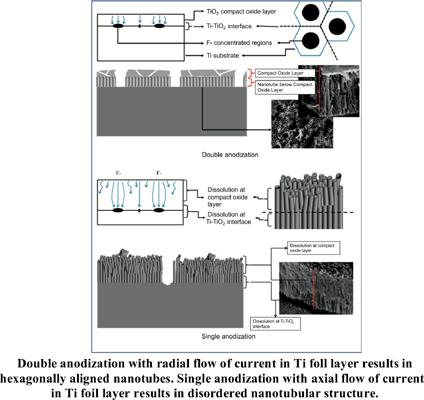Current Nanoscience ( IF 1.5 ) Pub Date : 2020-12-31 , DOI: 10.2174/1573413716999200529115830 Kar Chun Lee 1 , Khairul Arifah Saharudin 1 , Srimala Sreekantan 1

|
Background: One-dimensional titania nanotubes (TNT) have attracted increasing scientific and technological attention due to their physical properties and their potential applications. Dimensionality and well-aligned ordered structure have a crucial role in determining the properties and performance of titania nanotubes. Therefore, an understanding of the transformation and growth mechanisms to explain the origin of this nanomaterial symmetry is of great importance.
Objectives: The relationship between the direction of current flow and the morphology of the anodized foil was investigated to understand the influence of a compact oxide layer formation on the growth of nanotubes.
Methods: To achieve the purpose, single (SA) and double-sided anodization (DA) were performed to control the direction of the current flow in this experiment by immersing one side and both sides, respectively in the electrolyte containing 0.6 wt% of NH4F, 1.0 wt% of H2O2, and 98.4 wt% of ethylene glycol (EG) at 60V.
Results: It was found that the channeling of current flow into axial and radial directions influenced the effectiveness of oxygen species in the formation of an initial oxide layer. The field-assisted dissolution of the compact oxide layer resulted in a low-symmetry nanotube arrangement, whereas the growth at the interface, which is governed by the plastic flow mechanism, resulted in high-symmetry nanotube arrangement in a hexagonal form. These findings offer an integrated perspective when determining whether the plastic flow mechanism or field-assisted dissolution occurs during anodization. Octahedral titania crystals were also found on the surface of the anodized film, indicating the possibility of forming facet structures via anodization.
Conclusion: This research successfully showed the influence of current flow via SA & DA on the growth of TiO2 nanotubes. An axial flow of current in Ti foil during SA resulted in disordered nanotubes, while the radial flow of current during DA stemmed the growth of nanotubes from the Ti-TiO2 interface to form well oriented hexagonal nanotube structures.
中文翻译:

轴向和径向电流对钛箔进行阳极氧化处理后,有序纳米管结构的形态学发展
背景:一维二氧化钛纳米管(TNT)由于其物理性质和潜在应用而吸引了越来越多的科学技术关注。尺寸和排列整齐的有序结构在决定二氧化钛纳米管的性能和性能方面起着至关重要的作用。因此,了解解释这种纳米材料对称性起源的转化和生长机理非常重要。
目的:研究电流方向与阳极氧化箔形态之间的关系,以了解致密氧化物层的形成对纳米管生长的影响。
方法:为达到此目的,在本实验中,通过将一侧和两侧分别浸入含0.6 wt%NH的电解液中,进行了单次(SA)和双面阳极氧化(DA)来控制电流的方向。4 F,1.0 V%的H 2 O 2和98.4 wt%的乙二醇(EG)在60V下。
结果:发现电流沿轴向和径向的通道化影响了氧物种在初始氧化物层形成中的有效性。致密氧化物层的场辅助溶解导致低对称纳米管排列,而在界面处的增长(由塑性流动机制控制)导致六边形形式的高对称纳米管排列。当确定在阳极氧化过程中是否发生塑性流动机制或现场辅助溶解时,这些发现提供了一个综合的观点。在阳极氧化膜的表面上还发现了八面体二氧化钛晶体,这表明可能通过阳极氧化形成小面结构。
结论:这项研究成功地表明了通过SA和DA的电流对TiO 2纳米管生长的影响。在SA期间,Ti箔中的轴向电流导致无序的纳米管,而在DA期间,径向电流阻止了Ti-TiO 2界面上纳米管的生长,从而形成了取向良好的六角形纳米管结构。



























 京公网安备 11010802027423号
京公网安备 11010802027423号